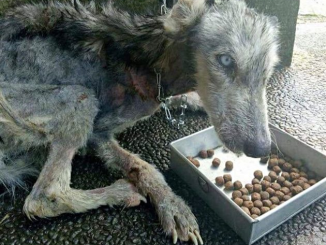Dogs’ brains are sensitive to the familiar high-pitched “cute” voice tone that adult humans, especially women, use to talk to babies, according to a new study.
The research, published recently in the journal Communications Biology, found “exciting similarities” between infant and dog brains during the processing of speech with such a high-pitched tone feature.
Humans tend to speak with a specific speech style characterised by exaggerated prosody, or patterns of stress and intonation in a language, when communicating with individuals having limited language competence.
Such speech has previously been found to be very important for the healthy cognitive, social and language development of children, who are also tuned to such a high-pitched voice.
But researchers, including those from the Eötvös Loránd University in Hungary, hoped to assess whether dog brains are also sensitive to this way of communication.
In the study, conscious family dogs were made to listen to dog, infant and adult-directed speech recorded from 12 women and men in real-life interactions.
As the dogs listened, their brain activities were measured using a functional magnetic resonance imaging (fMRI) scan.
The study found the sound-processing regions of the dogs’ brains responded more to dog- and infant-directed than adult-directed speech.
This marked the first neurological evidence that dog brains are tuned to speech directed specifically at them.
“Studying how dog brains process dog-directed speech is exciting, because it can help us understand how exaggerated prosody contributes to efficient speech processing in a nonhuman species skilled at relying on different speech cues,” explained Anna Gergely, co-first author of the study.
Scientists also found dog- and infant-directed speech sensitivity of dog brains was more pronounced when the speakers were women, and was affected by voice pitch and its variation.
These findings suggest the way we speak to dogs matters, and that their brain is specifically sensitive to the higher-pitched voice tone typical to the female voice.
“Remarkably, the voice tone patterns characterizing women’s dog-directed speech are not typically used in dog-dog communication – our results may thus serve evidence for a neural preference that dogs developed during their domestication,” said Anna Gábor, co-first author of the study.
“Dog brains’ increased sensitivity to dog-directed speech spoken by women specifically may be due to the fact that women more often speak to dogs with exaggerated prosody than men,” Dr Gabor said.

A Hero’s Farewell: Pitbull Dog’s Tear-Jerking Sacrifice to Save Beloved Owner

In a brave act of loyalty, a pit bull named Nong Horm protected her owners by fearlessly confronting a serpent in her family’s backyard situated in Pathum Thani, Thailand. Tragically, Nong Horm succumbed to the poisonous bite of the snake while defending her loved ones.

Nong Horm, who was almost due to give birth, fearlessly faced a monocled snake – known to be one of the most lethal snakes in the world. The brave pitbull intervened and bit the snake’s lips, causing the venom to act rapidly and kill it.

In a flash, the family was unable to act as the situation unfolded. Suriyon Chanthakhet, the proprietor, shared his remorse regarding the event. “Our exceptional dog lost her life trying to protect us from the snake,” he stated. The news is devastating, and it’s causing me overwhelming sadness. “I can’t imagine the agony she must have gone through,” he added, choked up with emotion.

In the photo shown above, Suriyon expresses her grief over the passing of her beloved canine companion, Nong Horm. She wonders why such a tragic event had to occur. Despite the unfortunate circumstances, Nong Horm was a remarkable and admirable dog



Leave a Reply